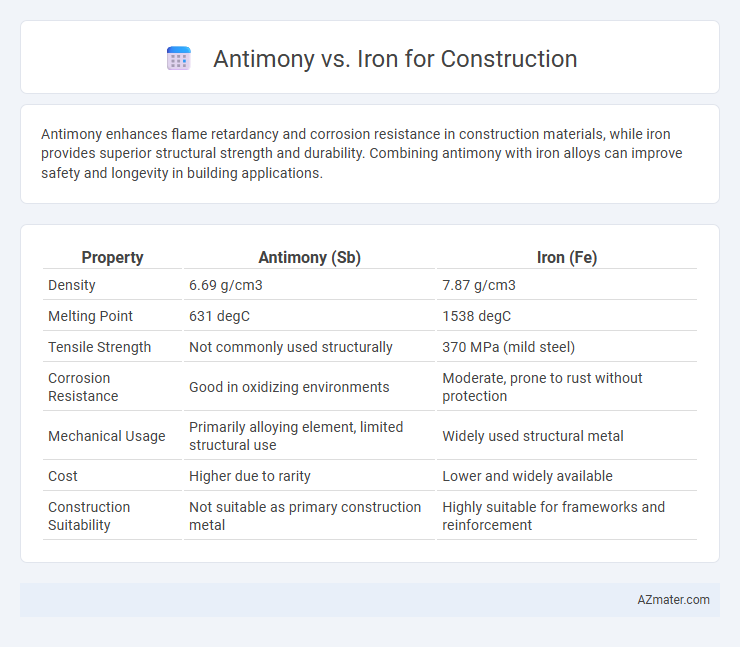Antimony enhances flame retardancy and corrosion resistance in construction materials, while iron provides superior structural strength and durability. Combining antimony with iron alloys can improve safety and longevity in building applications.
Table of Comparison
| Property | Antimony (Sb) | Iron (Fe) |
|---|---|---|
| Density | 6.69 g/cm3 | 7.87 g/cm3 |
| Melting Point | 631 degC | 1538 degC |
| Tensile Strength | Not commonly used structurally | 370 MPa (mild steel) |
| Corrosion Resistance | Good in oxidizing environments | Moderate, prone to rust without protection |
| Mechanical Usage | Primarily alloying element, limited structural use | Widely used structural metal |
| Cost | Higher due to rarity | Lower and widely available |
| Construction Suitability | Not suitable as primary construction metal | Highly suitable for frameworks and reinforcement |
Introduction to Antimony and Iron in Construction
Antimony is primarily used in construction for its flame-retardant properties and as an alloying element in lead-based materials, enhancing durability and corrosion resistance. Iron, a fundamental material in construction, offers exceptional strength, versatility, and load-bearing capacity, making it essential for steel production used in beams, reinforcements, and structural frameworks. Comparing these materials highlights iron's critical role in structural integrity, while antimony contributes to material enhancement and safety features in construction applications.
Material Properties: Antimony vs Iron
Antimony exhibits a low melting point of 630.6degC and a density of 6.697 g/cm3, making it less suitable for structural support in construction compared to iron, which has a high melting point of 1538degC and a density of 7.874 g/cm3, providing superior strength and durability. Iron's tensile strength ranges from 370 to 440 MPa, far exceeding antimony's brittleness and lack of tensile strength. Corrosion resistance is another critical factor; iron can be alloyed into steel with protective coatings, whereas antimony is primarily used as a flame retardant or alloying element rather than a primary construction material.
Strength and Durability Comparison
Antimony alloys enhance corrosion resistance and hardness but lack the tensile strength and load-bearing capacity found in iron, making iron the preferred choice for structural construction. Iron's superior durability under heavy stress and its ability to withstand environmental wear ensures long-lasting performance in building frameworks. While antimony improves material hardness in specific applications, iron's robustness and toughness provide essential strength for safely supporting large-scale construction projects.
Corrosion Resistance: Which Performs Better?
Antimony enhances corrosion resistance when alloyed with metals but is rarely used alone in construction due to its brittleness. Iron, especially in the form of steel, provides strong structural integrity but is prone to rust and corrosion without protective coatings or treatments like galvanization. In terms of corrosion resistance, iron alloys with specific treatments outperform pure antimony, making iron-based materials more practical for durable construction applications.
Weight and Density Differences
Antimony has a density of approximately 6.68 g/cm3, significantly lower than iron's density of about 7.87 g/cm3, making iron heavier and more suitable for applications requiring high strength and weight-bearing capacity. The lower weight of antimony can be advantageous in construction scenarios where reduced load is critical, but its brittleness limits structural use compared to iron. Iron's higher density contributes to its durability and load resistance, essential factors in building infrastructure and heavy-duty frameworks.
Cost Analysis: Antimony vs Iron
Antimony's cost in construction is generally higher than iron due to its rarity and specialized applications, making it less economical for large-scale projects. Iron offers a significantly lower price per ton, with well-established supply chains contributing to its cost-effectiveness in structural use. The long-term maintenance and durability of iron further enhance its affordability compared to antimony-based materials.
Environmental Impact and Sustainability
Antimony exhibits higher toxicity and poses greater environmental risks during extraction and disposal compared to iron, which is more abundant and recyclable with a lower ecological footprint. Iron's widespread use in construction benefits sustainability through efficient recycling processes that significantly reduce energy consumption and greenhouse gas emissions. Sustainable building practices prioritize iron due to its durability, recyclability, and comparatively minimal impact on ecosystems throughout its lifecycle.
Applications in Modern Construction
Antimony is primarily used as a flame retardant and in alloying to enhance metal strength and corrosion resistance in specialized construction materials, while iron remains the fundamental element in structural frameworks due to its high tensile strength and versatility. Modern construction heavily relies on iron-based steel alloys for beams, reinforcements, and concrete reinforcements, whereas antimony finds niche applications in fireproof coatings and as a stabilizer in cement products. The complementary use of iron for load-bearing structures and antimony for enhancing material safety highlights their distinct yet critical roles in advancing building durability and fire resistance.
Safety Considerations and Health Risks
Antimony is a toxic metalloid that poses significant health risks such as respiratory irritation, skin disorders, and potential carcinogenic effects, making it less suitable for construction where prolonged human exposure occurs. Iron, widely used in construction due to its strength and durability, has minimal health hazards when properly handled, though welding fumes and dust can cause occupational risks requiring safety measures. Choosing iron over antimony reduces toxicity concerns and enhances overall safety for workers and building occupants.
Future Trends and Innovations in Construction Materials
Antimony is emerging as a key additive in advanced construction materials, enhancing fire resistance and durability in composite panels, while iron continues to dominate structural frameworks due to its strength and versatility. Innovations in nanotechnology leverage antimony compounds to improve insulation properties and reduce environmental impact, signaling a shift towards smarter, sustainable building solutions. Future trends favor integrating antimony-infused materials with traditional iron reinforcements to achieve optimized performance in eco-friendly, resilient infrastructure.

Infographic: Antimony vs Iron for Construction
 azmater.com
azmater.com